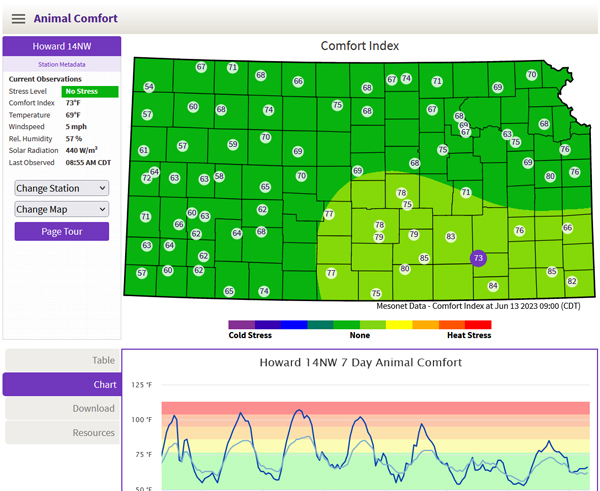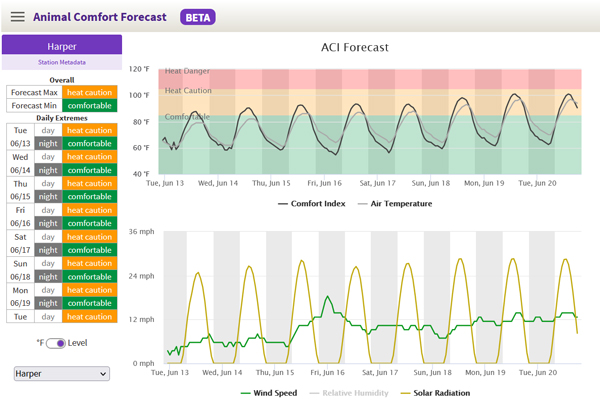It has been a year since a major cattle loss event occurred in southwest Kansas. This marked a time when producers were caught off guard by a sudden transition from cool/wet to hot conditions. As a result, the Kansas Mesonet has been coordinating with producers and researchers to provide a forecast product that will predict loss potential in the future.
Temperatures across Kansas are anticipated to increase substantially in the coming week compared to the recent cool/wet conditions. While this won’t bring 2022-like temperature swings, the new product will hopefully help decision-makers analyze the increased risk and take mitigation actions. Additionally, this product will remain useful even into the cold season and provide guidance for upcoming weather changes.
Current Animal Comfort
The Kansas Mesonet focuses on observations and recording historical data to build climate records. Mesonet has long provided current animal comfort indices derived from Mader et al. 2010 on their website (https://mesonet.k-state.edu/agriculture/animal/current). This product remains available to users and will continue to collect data (Figure 1). Unfortunately, for decision-makers, real-time data means that loss could already be occurring. Therefore, the need to provide advanced notice existed and couldn’t be captured on this website.

Figure 1. Real-time Animal Comfort data available on the Kansas Mesonet website (https://mesonet.k-state.edu/agriculture/animal/current).
Forecasting Animal Comfort
Since the June 2022 event, Mesonet staff coordinated with a group of producers and researchers to evaluate the feasibility of a forecast product. As a result of this collaboration, the Mesonet started incorporating the National Weather Service (weather.gov) data into the equation used on the current comfort product. The outcome is an hourly view of forecasts for the next seven days for each Mesonet station location. These forecasts can now be found online here: https://mesonet.ksu.edu/agriculture/animal/forecast. Both current and forecast products can also be found via the ≡ menu under “Agriculture” -> “Animal Comfort” (Figure 2).

Figure 2. Screenshot of the new Mesonet Animal Comfort Forecast product https://mesonet.ksu.edu/agriculture/animal/forecast/.
This new product focuses on the producer’s location, placing forecast charts above the statewide maps. These charts provide interactive hourly forecast data, similar to the “Hourly Forecast” product from the National Weather Service (https://forecast.weather.gov/MapClick.php?lat=37.2036&lon=-98.3863&unit=0&lg=english&FcstType=graphical).
The most significant change is the data displayed on the left where the peak values for the day (maximum) and night (minimum) can be found highlighted by their specific category (Figure 2). Overnight conditions are critical for cattle/livestock to recover, especially during periods of hot weather, similar to what is forecasted in the coming week. This provides a quick glimpse of the seven-day period that can advise producers of any periods during which they should be concerned.
Important note: The National Weather Service forecasts the hourly average values rather than extremes. In addition, fluctuations in cloud cover (affecting solar radiation) and wind speed have a large effect on the comfort level. Producers should recognize that localized conditions may be significantly warmer/colder than the predicted comfort index.
Categorical Changes
After feedback from users, we have simplified the categories from the original page, focusing on periods of concern from extreme heat or cold. While we cannot make assumptions on an animal's age, type, color, prevention plan, or health, we can make some basic estimates of peak levels that provide heightened risk, especially if extreme conditions have a rapid onset.
We now have a single “Comfortable” level that suggests there are very low amounts of atmospheric stress upon outdoor animals. When temperatures start to climb, we have a period of “Heat Caution” before reaching 105° F, a point when deaths potentially exceed 5% (Mader et al. 2010). Animal comfort indices above this value (the “Heat Danger” level) occur routinely every summer across the state. However, by peak summer, producers have typically taken mitigation measures and, when combined with higher animal endurance, likely won’t result in losses. This is especially true when temperatures fall overnight to enable animal recovery. Concerns should increase if nightly temperatures remain high or cattle are not adjusted to the heat. This was especially the issue last June and must be considered in the shoulder seasons. While this tool provides guidance, it is up to the producer to be able to monitor their animals and know when they should be concerned.
What makes this animal comfort index more versatile than the Temperature Humidity Index (THI) which is often used in livestock health management, is that it can handle cold factors as well. Values below -20° F have been associated with increased loss, especially in young cattle. This threshold is when the “Cold Danger” level is exceeded on the website. While this won’t happen in the summer, producers can still utilize the cold spectrum during the fall/spring calving season. Once again, large fluctuations in stress levels when animals are not adapted to the cold are very important.
The Future
This new product is the result of feedback from producers. We are striving to provide tools that improve field decisions and enhance Kansas agriculture. A huge thanks to all those who assisted in this project. If you feel additional changes could be made in the future, please don’t hesitate to reach out to the authors!
Christopher “Chip” Redmond - Kansas Mesonet Manager
christopherredmond@ksu.edu
Dan Regier - Kansas Mesonet Developer
regierdp@ksu.edu
Matthew Sittel - Assistant State Climatologist
msittel@ksu.edu
Anthony “AJ” Tarpoff
tarpoff@ksu.edu
References
Mader, T.L., Johnson, L.J., & Gaughan, J.B. (2010). A comprehensive index for assessing environmental stress in animals. Journal of animal science, 88 6, 2153-65